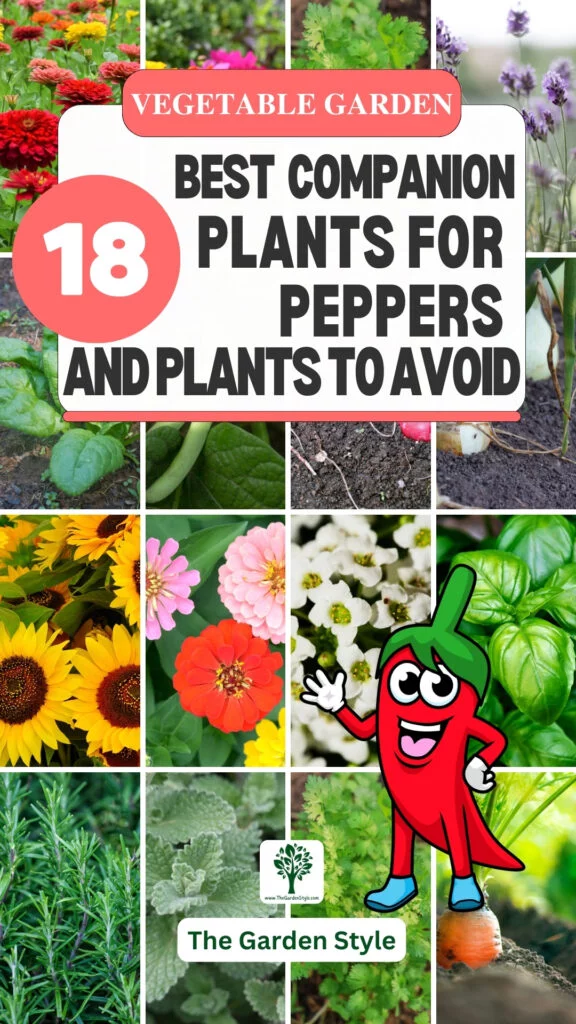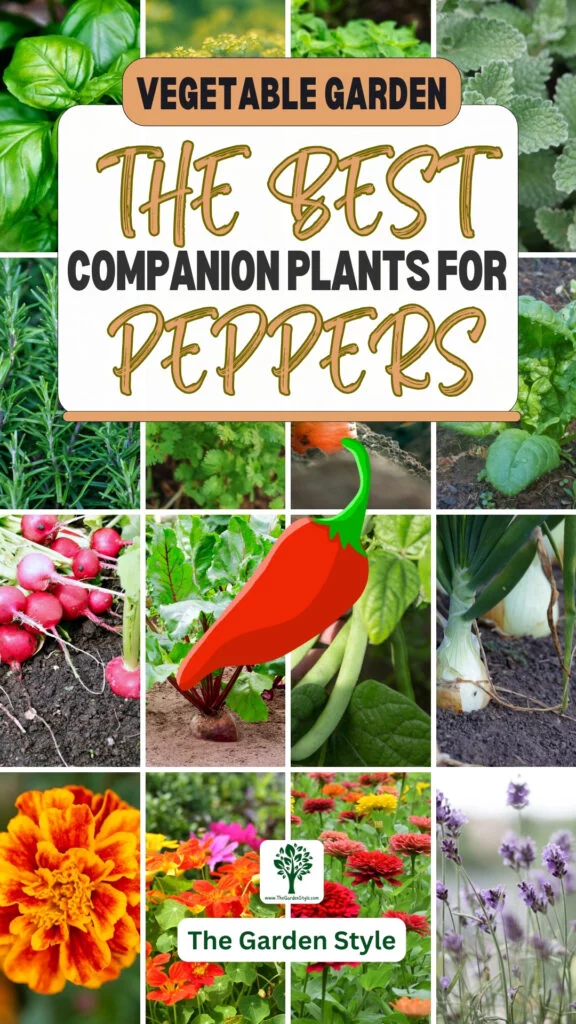If you’re a pepper lover looking to grow a bountiful and healthy crop, you’ll want to consider companion planting. Companion planting is the practice of growing different plant species together for mutual benefit. Not only can the right plant pairings enhance growth, flavor, and pest resistance for your peppers, but it’s also an eco-friendly way to create a balanced garden ecosystem. Let’s dive into some of the best companion plants for peppers!
Table of Contents
What are Companion Plants?
Companion plants are those that are purposefully grown alongside other crops to assist, whether it’s repelling pests, attracting beneficial insects, improving nutrient uptake, or increasing flavor. This symbiotic relationship helps create a low-maintenance, productive, and sustainable growing environment.
The benefits of companion planting include:
- Pest and disease control through natural repellents or traps
- Attracting pollinators and predatory beneficial insects
- Improving soil nutrients through nitrogen fixation
- Providing shade, wind protection, or ground cover
- Enhancing growth and flavor through symbiotic relationships
With the right plant pairings, you can leverage these advantages to give your pepper plants everything they need to thrive truly.
The Best Companion Plants for Peppers
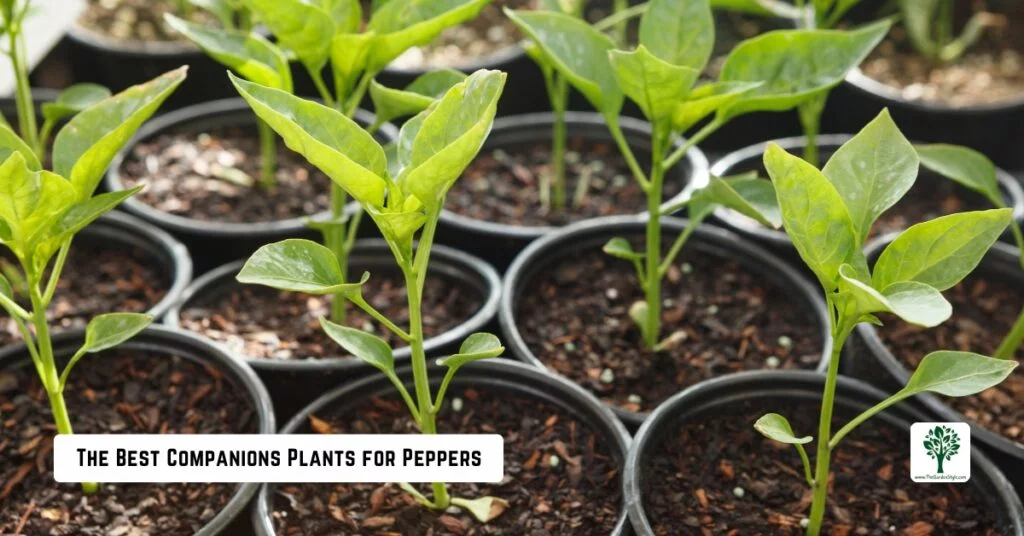
When it comes to companion plants for peppers, selecting the right crops to grow alongside them can elevate your garden’s productivity. That applies to all varieties of peppers, whether you’re growing sweet bell peppers, spicy chili peppers, banana peppers, jalapeños, habaneros, or any other types.
Companion planting allows you to take advantage of beneficial relationships between different plant species. The ideal companions can deter pests, improve nutrients, and boost pepper growth and yields for your whole pepper crop. From herbs and flowers to vegetable crops, numerous excellent companion plants for peppers make invaluable garden neighbors, no matter which specific pepper varieties you cultivate.
Companion Herbs for Peppers
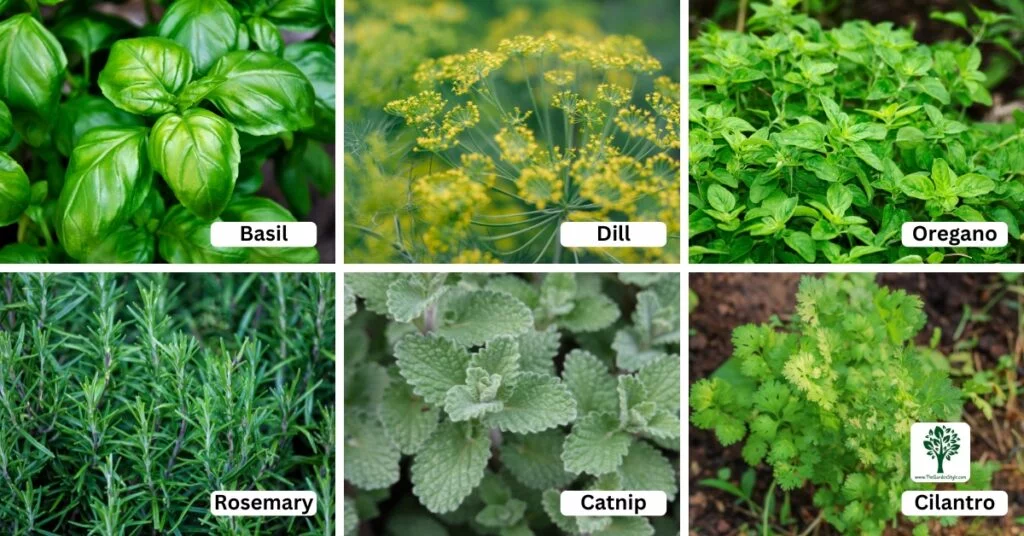
Basil: An aromatic annual herb with a strong scent that deters aphids, spider mites, thrips, and mosquitoes from bothering pepper plants. Its roots also help aerate the soil and provide channels for the peppers’ roots to access nutrients. Learn how to plant basil.
Dill: This annual herb with wispy foliage and yellow flowers attracts many beneficial insects like ladybugs, lacewings, and parasitic wasps that prey on aphids and other pests. The oils in dill can also help mask scents that would otherwise draw harmful pests. Learn how to grow dill.
Oregano: A perennial herb known for its pungent aroma, oregano’s scent confuses and deters many insect pests from finding pepper plants when grown as a companion. It also attracts beneficial predator insects.
Rosemary: The drought-tolerant and woody perennial herb rosemary improves flavor in peppers when planted nearby, thanks to its ability to increase essential oil production. Its piney scent can also deter cabbage moths, beetles, and other insects.
Catnip: While it drives cats crazy, the strong menthol scent of catnip effectively repels flea beetles, aphids, squash bugs, and other problematic pests from the pepper patch when used as a companion planting.
Cilantro: The lacy foliage and umbels of this annual herb attract many predatory wasps and other beneficial insects that remove insects and eggs from pepper plants. Its strong scent can also deter aphids, spider mites, and whiteflies.
Companion Vegetables for Peppers
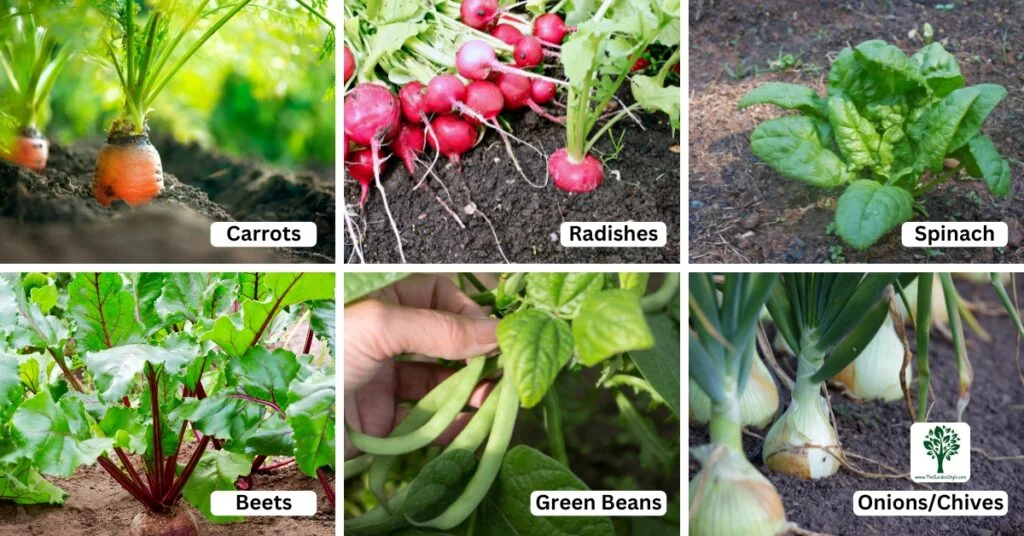
Carrots: Carrot plants help loosen and aerate the soil with their thin roots, improving drainage and creating channels for nearby pepper plants to access water and nutrients. Their feathery tops also provide light shading to retain soil moisture.
Radishes: These fast-growing root vegetables can help break up and loosen compacted soils with their taproots. The radish greens also provide ground cover to suppress weeds and preserve moisture for peppers. Radishes contain compounds that repel pests like cucumber beetles. Learn how to grow radishes.
Spinach: The low, spreading growth of spinach creates a living mulch around pepper plants that suppresses weed growth while preserving soil moisture. As it grows, spinach also provides nutrients to enrich the soil.
Beets: Beta vulgaris, like their close relative Swiss chard, is known for producing a biochemical that deters nematodes and other soil-dwelling pests that could otherwise damage pepper root systems and stunt growth.
Green Beans: Bush and pole bean varieties are excellent nitrogen-fixing legume companions that help provide a steady supply of nitrogen to fuel lush foliage growth in the “heavy feeder” pepper plants.
Onions/Chives: Members of the allium family, like onions, garlic, and chives, release sulfuric odors that confuse and deter many insect pests while their shallow roots compete minimally with peppers. Their odor can also enhance pepper flavor.
Companion Flowers for Peppers
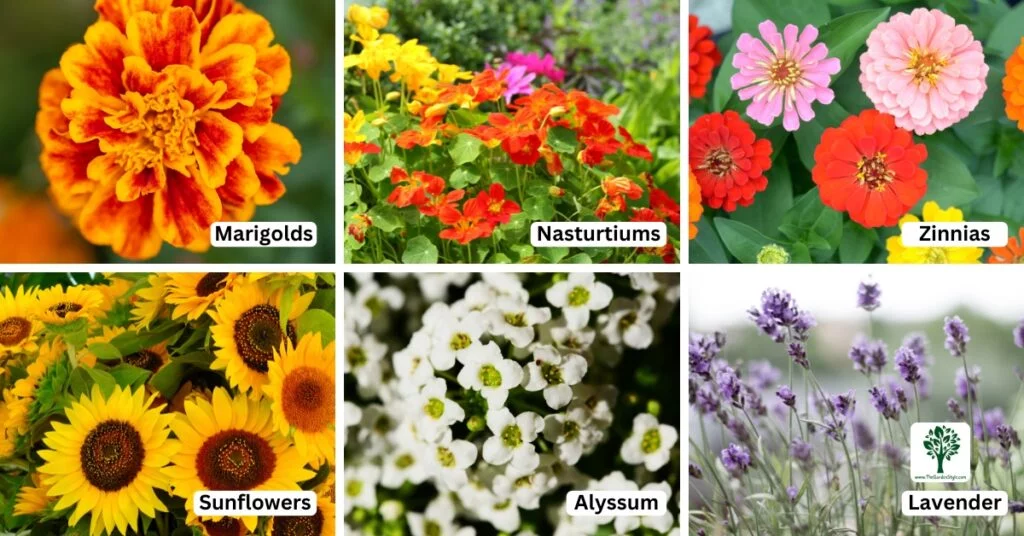
Marigolds: These vibrant flowers contain a bioactive compound called alpha-terthienyl that is toxic to nematodes and other soil-dwelling pests and pathogens that could otherwise harm pepper roots and plants. They also attract pollinators and other beneficial insects. Learn how to grow marigolds.
Nasturtiums: Distinctive for their rounded, shield-shaped leaves, nasturtiums act as a trap crop by attracting aphids and whiteflies away from pepper plants thanks to the powerful volatile compound they emit. They’re also edible with a peppery flavor.
Zinnias: The bright, daisy-like blooms of zinnias attract beneficial insects like ladybugs, lacewings, and pollinators. They make an excellent flowering companion to add splashes of color to the pepper garden. Learn how to plant zinnias from seeds.
Sunflowers: In addition to attracting pollinators, sunflowers provide light afternoon shade for pepper plants during their hottest hours, preventing issues like sunscald. Their tall stalks also offer physical support as a trellis for sprawling pepper vines.
Alyssum: Forming thick mats of tiny flowers, sweet alyssum is highly attractive to many small parasitic wasps and other beneficial insects that prey on aphids, thrips, whiteflies, and other problem pests of pepper plants.
Lavender: With its distinctive purple blooms and calming herbal scent, lavender can repel pest insects like whiteflies and moths while attracting pollinators. Its drought tolerance and ability to improve drainage are also beneficial for pepper plants. Learn how to propagate lavender.
At a Glance: Peppers Companion Planting Chart
| Companion Plant for Peppers | Type | Benefits for Peppers |
| Basil | Herb | Deters aphids, spider mites, thrips, mosquitoes; Aerates soil; Provides nutrient channels. |
| Dill | Herb | Attracts beneficial insects; Masks scents that draw pests |
| Oregano | Herb | Confuses and deters pests; Attracts beneficial predators |
| Rosemary | Herb | Improves flavor; Deters cabbage moths, beetles |
| Catnip | Herb | Repels flea beetles, aphids, squash bugs |
| Cilantro | Herb | Attracts predatory wasps; Deters aphids, spider mites, whiteflies |
| Carrots | Vegetable | Loosens soil; Improves drainage; Provides shade and moisture retention |
| Radishes | Vegetable | Breaks up compacted soil; Ground cover; Repels cucumber beetles |
| Spinach | Vegetable | Living mulch; Suppresses weeds; Enriches soil |
| Beets | Vegetable | Deters nematodes and soil pests |
| Green Beans | Vegetable | Nitrogen fixation for foliage growth |
| Onions/Chives | Vegetable | Confuses and deters pests; Enhances flavor |
| Marigolds | Flower | Toxic to nematodes and soil pests; Attracts pollinators |
| Nasturtiums | Flower | Trap crop for aphids and whiteflies; Edible |
| Zinnias | Flower | Attracts beneficial insects and pollinators; Adds color |
| Sunflowers | Flower | Provides afternoon shade; Support for vines; Attracts pollinators |
| Alyssum | Flower | Attracts parasitic wasps that prey on pests |
| Lavender | Flower | Repels whiteflies and moths; Attracts pollinators; Improves drainage |
Plants to Avoid Planting Near Peppers
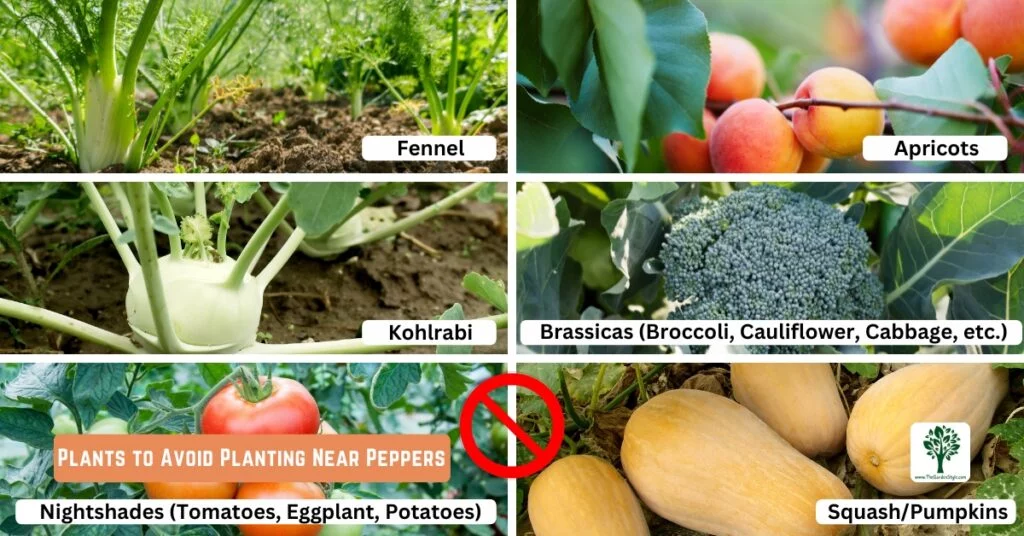
Just as some plants make excellent companions for peppers, there are others that should be avoided in close proximity. These incompatible plants can compete for resources, attract pests and diseases, or cause other issues detrimental to your pepper crop. Steer clear of growing the following too close to your peppers:
Fennel: With its tall growth habit and voracious water and nutrient needs, fennel makes for a very poor neighbor to pepper plants. Its root system can outcompete and deprive your peppers of precious resources. Fennel may also contribute to stunted growth and decreased fruiting in peppers.
Apricots: As a member of the Prunus genus, apricot trees should be kept far away from the pepper patch. Like other stone fruits, apricots are a host for the devastating verticillium wilt fungus, which can remain in the soil for years after infection. It’s best to avoid this disease vector altogether when growing solanaceous crops like peppers.
Kohlrabi: While its crunchy bulbs make for a tasty side dish, kohlrabi competes heavily for nutrients when grown in proximity to peppers. It has a very extensive, fibrous root system that can starve nearby plants. Plus, its tall growth tends to shade out smaller crops and create lots of unwanted debris in the garden.
Brassicas (Broccoli, Cauliflower, Cabbage, etc.): Most plants in the brassica family should be segregated from your pepper plants. They attract many of the same insect pests like aphids, flea beetles, and caterpillars. Their large size and rapid growth can also outcompete and shade out the peppers.
Nightshades (Tomatoes, Eggplant, Potatoes): While closely related nightshade crops may seem like natural companions, issues can arise from planting peppers too close. They are all susceptible to many of the same diseases, pests, and nutrient deficiencies, which can spread easily between them when crowded together.
Squash/Pumpkins: The dense foliage and sprawling vines of squash and pumpkin plants will quickly smother and outcompete pepper plants for space, light, and nutrients if planted in the same area. Their large leaves can also contribute to fungal issues when shading peppers.
| Plants to Avoid with Peppers | Reason to Avoid |
| Fennel | Competes for water and nutrients; Can stunt growth and fruiting |
| Apricots | Host verticillium wilt fungus, which can infect peppers |
| Kohlrabi | Competes heavily for nutrients; Extensive root system; Excessive shading |
| Brassicas (Broccoli, Cauliflower, Cabbage, etc.) | Attract shared insect pests; Outcompete and shade peppers. |
| Nightshades (Tomatoes, Eggplant, Potatoes) | Susceptible to the same diseases/pests/deficiencies that can spread |
| Squash/Pumpkins | Smother and outcompete for space, light, and nutrients; Can increase fungal issues. |
By avoiding these incompatible plants near your peppers, you can prevent many problems with competition, pests, diseases, and more from arising in the first place. A little planning goes a long way!
Tips for Successful Companion Planting with Peppers
When planning your pepper plant pairings, be sure to consider factors like growth rate, size, root depth, and spacing needs. For best results:
- Allow 18-24 inches between pepper plants and their companions
- Amend soil with compost or aged manure before planting
- Install drip irrigation or soaker hoses to ensure consistent moisture
- Rotate crop locations yearly to prevent disease and pest issues
- Grow sprawling crops like squash a safe distance from peppers
With some simple planning, the rewards of a thriving, interplanted vegetable garden will pay off deliciously!
Final Conclusions
From flavorful herbs and vibrant flowers to crunchy veggies and more, there’s no shortage of potential plant partners to give your pepper crop a boost. By following the principles of companion planting, you can create a balanced, biodiverse garden that’s low-maintenance while delivering better harvests. So grab your trowel and get ready to mingle some peppers with their perfect pals for an unbeatable homegrown bounty.
Frequently Asked Questions
Flowering herbs like dill, cilantro, lavender, and bee balm are excellent for luring pollinating insects like bees, butterflies, and hummingbirds. Pollinators help ensure a bountiful pepper harvest!
These two plants actually make poor garden neighbors. Strawberries prefer a more acidic soil, while peppers thrive in neutral to slightly alkaline conditions. Their drastically different soil needs make them an incompatible pairing.
Some key pests that companion planting can combat include aphids, spider mites, nematodes, cutworms, flea beetles, and more, depending on the specific plant pairing. Many herbs are beneficial for repelling troublesome insects.
If this post about the best companion plants for peppers was helpful, please share it:
